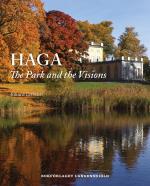Engelska
Mest sålda

-
Title:
Tyresö Palace
-
Reviews:
-
Release Date:
-
Genre:
- Kulturhistoria
-
Format:
Bok
-
Availability:
Beställningsvara Leveranstid: från 3 vardagar
-
Description:
Tyresö Palace is a stately home south of Stockholm, owned by the Nordic Museum. Today it is encircled by urban expansion, yet it dominates the surroundings with its beautiful location at the highest point of a peninsula in the inner archipelago. The present palace was originally built in the 1630s,...
Tyresö Palace is a stately home south of Stockholm, owned by the Nordic Museum. Today it is encircled by urban expansion, yet it dominates the surroundings with its beautiful location at the highest point of a peninsula in the inner archipelago. The present palace was originally built in the 1630s, but the interior that visitors meet today shows what it looked like as a private country residence around 1900. The book tells about the history of the site, of the buildings and parks, and also about owners, servants and visiting artists.

-
Title:
Haga - The Park And The Visions
-
Reviews:
-
Release Date:
-
Genre:
- Kulturhistoria
-
Format:
Bok
-
Availability:
Beställningsvara Leveranstid: från 3 vardagar
-
Description:
What would Haga Park have looked like today if Swedish King Gustav III had survived the shot at the masquerade ball on March 16, 1792? Drawings and construction plans give us some idea. The English park was the new trend in Europe and Brunnsviken's varied nature was exceptionally suitable for such ...
Haga - The Park And The Visions Bok
<p>What would Haga Park have looked like today if Swedish King Gustav III had survived the shot at the masquerade ball on March 16, 1792? Drawings and construction plans give us some idea. The English park was the new trend in Europe and Brunnsviken's varied nature was exceptionally suitable for such a park. Thus, Haga was thought of as a future Venice, an oasis where water channels would flow through the landscape and the king would spend his leisure time. Take an excursion to Haga and bring the book as a guide to see history unfold as told in the book<b>.</b> Or stay at home and let the text and images tell the fascinating story of Haga.</p><p style="margin:0cm 0cm 10pt;">This book is the work of the stone conservator <b>Rikard Larsson</b>.</p>

-
Title:
The Portals Of Stockolms Old Town
-
Reviews:
-
Release Date:
-
Genre:
- Kulturhistoria
-
Format:
Bok
-
Availability:
Beställningsvara Leveranstid: från 3 vardagar
-
Description:
Rediscover Stockholm's Old Town with the help of this beautifully illustrated book. Read about the rich cultural heritage of its ornate portals with their stories of local life and their history stretching from the late Middle Ages to modern times. Follow the various shifts in architectural style w...
The Portals Of Stockolms Old Town Bok
<p>Rediscover Stockholm's Old Town with the help of this beautifully illustrated book. Read about the rich cultural heritage of its ornate portals with their stories of local life and their history stretching from the late Middle Ages to modern times. Follow the various shifts in architectural style while learning about 17th century stonemasons, about portals as status symbols and about the motifs and significance of their ornamentation. Read how the richness of the baroque portal is succeeded by the simplicity of 18th century designs, how new technologies and cast iron emerge in the 19th century and, finallt, how the eatly 20th century brings about a renaissance in terms of craftmanship and the use of natural stone. </p><p>To everyone's great joy, the Old Town and its portals have survived into the modern era despite the threats of demolition and air pollution. With the help of the enclosed map and its markings, you can now plan your own exciting walks.</p><p>This book and its newly taken photographs are the work of the stone conservator Rikard Larsson.</p>

-
Title:
How Neocons Tried To Destroy The World - Russia After Yeltsin
-
Reviews:
-
Release Date:
-
Genre:
- Historia & Arkeologi
-
Format:
Bok
-
Availability:
Beställningsvara Leveranstid: från 3 vardagar
-
Description:
After President George H W Bush's reelection defeat, formulating a long-term policy toward post-Soviet Russia fell to Bill Clinton, who became president in January 1993. The general approach adopted by the Clinton administration - its underlying assumptions, purposes, and implementation - has been ...
After President George H W Bush's reelection defeat, formulating a long-term policy toward post-Soviet Russia fell to Bill Clinton, who became president in January 1993. The general approach adopted by the Clinton administration - its underlying assumptions, purposes, and implementation - has been Washington's policy ever since, through both terms of the second President Bush. It was still in place when President Barack Obama took office in January 2009. President Donald Trump has tried to change this but seems in this question completely be ruled by 'DEEP STATE'. Given Russia's singular potential for both essential cooperation and unprecedented dangers, the Clinton administration inherited historic responsibility for, as pundits say, getting Russia policy right. It failed disastrously, though officials involved in those decisions have continuedto defend these failures. It does not require a degree in international relations to understand that the first principle of policy toward post-Communist Russia should have been to heed the Hippocratic injunction: Do no harm! Do nothing to undermine its fragile stability, nothing to dissuade the Kremlin from giving first priority to repairing the nation's crumbling infrastructures, nothing to cause it to rely more heavily on its stockpiles of superpower weapons instead of reducing them, nothing to make Moscow less than fully cooperative with the West in those and other vital pursuits. Everything else in that shattered country was of far less consequence. Instead, beginning in the early 1990s, Washington simultaneously conducted, underDemocrats and Republicans, two fundamentally different policies toward post-Soviet Russia - one decorative and outwardly reassuring, the other real and exceedingly reckless. The decorative policy, which was generally taken at face value in the UnitedStates professed to have replaced America's previous Cold War intentions with a generous relationship of "strategic partnership and friendship". The public image of this approach featured happy-talk meetings between the American and Russian presidents, first "Bill and Boris" (Clinton and Yeltsin), then "George and Vladimir" (Bush and Putin). The real US policy was different - a relentless, winner-take-all exploitation of Russia`s post-1991 weakness. Accompanied by broken American promises, condescending lectures, and demands for unilateral concessions, it was, and remains, disregardingofficial rhetoric, even more aggressive and uncompromising than was Washington`s approach to Soviet Communist Russia. It is important to specify the defining elements of this actual policy as they unfolded - with fulsome support in both major American political parties, influential media, and liberal and conservative think tanks - since the early 1990s, if only because they are firmly lodged in Moscow`s memory: Morimer Zuckerman, member of New York Council for Foreign Relations, owner to US News & World Report, describes what happened at the plunder of Russia under Yeltsin. Boris Yeltsin and his "free market reformers" were part of one of the most hidden and most criminal looting operations in CIA history. It was the rape of Russia by a corrupted circle of treasonous Soviet KGB generals, together with their select young KGB protégés, who were transformed through the operation into billionaire oligarchs. It was an economic rape made possible only through Western banks and the so-called "democracy machinery" of Washington under three successive presidents - Ronald Reagan, George H.W. Bush, and Bill Clinton. A growing military encirclement of Russia, on and near its borders, by US and NATO bases, which by August 2008 were already ensconced or being planned in at least half of the fourteen other former Soviet republics, from the Baltics and Ukraine to Georgia, Azerbaijan, and the new states of Central Asia. The result is a reemerging iron curtain and the remilitarization of American-Russian relations, developments only belatedly noted, and almost always misexplained, in the United States. In the aftermath of the 2008 Georgian War, for example, a US senator angrily declared. "We`re not going to let Russia, so soon after the Iron Curtain fell, to again draw a dividing line across Europe." A New York Times editorial added that such a 'redivision of Europe' could not be tolerated." But it was the eastward expansion of the NATO military alliance, beginning in the 1990s, that imposed 'new dividing lines in Europe,' certainly in the eyes of Russia`s political leaders, and threatened their country with 'being pushed' behind a new 'iron curtain'.
Utvalt - Engelska
After President George H W Bush's reelection defeat, formulating a long-term policy toward post-Soviet Russia fell to Bill Clinton, who became president in January 1993. The general approach adopted ...
- Populärt
- Mest sålda
- Mest bokade
- Senast släppta
- Kommande
- Pris
- A-Ö
- Välj
- 0 - 9
- A
- B
- C
- D
- E
- F
- G
- H
- I
- J
- K
- L
- M
- N
- O
- P
- Q
- R
- S
- T
- U
- V
- W
- X
- Y
- Z
- Å
- Ä
- Ö
- Övrigt
